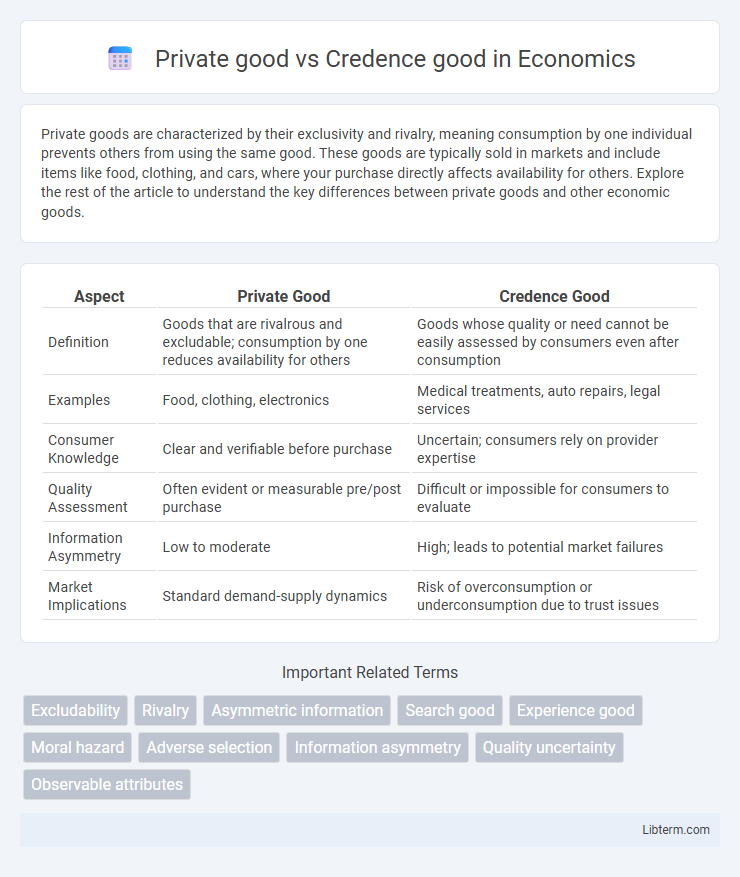Private goods are characterized by their exclusivity and rivalry, meaning consumption by one individual prevents others from using the same good. These goods are typically sold in markets and include items like food, clothing, and cars, where your purchase directly affects availability for others. Explore the rest of the article to understand the key differences between private goods and other economic goods.
Table of Comparison
| Aspect | Private Good | Credence Good |
|---|---|---|
| Definition | Goods that are rivalrous and excludable; consumption by one reduces availability for others | Goods whose quality or need cannot be easily assessed by consumers even after consumption |
| Examples | Food, clothing, electronics | Medical treatments, auto repairs, legal services |
| Consumer Knowledge | Clear and verifiable before purchase | Uncertain; consumers rely on provider expertise |
| Quality Assessment | Often evident or measurable pre/post purchase | Difficult or impossible for consumers to evaluate |
| Information Asymmetry | Low to moderate | High; leads to potential market failures |
| Market Implications | Standard demand-supply dynamics | Risk of overconsumption or underconsumption due to trust issues |
Understanding Private Goods: Definition and Characteristics
Private goods are defined by their excludability and rivalrous consumption, meaning consumers can be prevented from using them and one person's consumption reduces availability for others. Typical characteristics include tangible products like clothing and food, where ownership is exclusive and usage directly diminishes quantity or utility for others. Understanding private goods involves recognizing their clear market boundaries, allowing straightforward pricing and exchange mechanisms in competitive markets.
What Are Credence Goods? Key Features Explained
Credence goods are products or services whose quality or benefits are difficult for consumers to evaluate even after consumption, such as medical treatments or legal advice. Key features include information asymmetry between buyers and sellers, reliance on expert knowledge, and trust in the provider's claims. Unlike private goods, credence goods require consumers to trust the seller due to the complexity or uncertainty in assessing value or necessity.
Core Differences: Private Goods vs Credence Goods
Private goods possess excludability and rivalrous consumption, meaning consumers can be prevented from usage and one person's consumption diminishes availability for others. Credence goods are characterized by the difficulty for consumers to evaluate quality even after purchase, relying heavily on trust and expertise, as seen in services like medical treatments or car repairs. The core difference lies in the evaluability of quality; private goods allow direct assessment by consumers, whereas credence goods require external validation or expert knowledge.
Examples of Private Goods in Everyday Life
Private goods in everyday life include items such as clothing, food, and smartphones, which are both rivalrous and excludable, meaning consumption by one person reduces availability for others and access can be restricted. These goods are contrasted with credence goods, like medical treatments or car repairs, whose quality or necessity is difficult for consumers to verify even after purchase. Examples like a loaf of bread or a pair of shoes highlight private goods' clear ownership and direct consumption benefits.
Common Types of Credence Goods in Modern Markets
Common types of credence goods in modern markets include healthcare services, legal advice, and automobile repairs, where consumers struggle to evaluate quality even after consumption. These goods rely heavily on expert trust and reputation due to the difficulty in assessing the true value or necessity of the service provided. Unlike private goods, which are easily evaluated based on direct usage, credence goods pose asymmetric information challenges that shape market dynamics and consumer behavior.
Consumer Trust: The Role of Information in Credence Goods
Consumer trust in credence goods hinges on the quality and transparency of information since these goods possess attributes difficult for buyers to verify even after consumption. Unlike private goods where quality is easily observable and verifiable, credence goods require consumers to rely heavily on expert opinions, certifications, and reputation signals to make informed decisions. Effective information dissemination and credible third-party endorsements significantly reduce information asymmetry, enhancing consumer confidence and purchase intentions in credence markets.
Market Failures Associated with Credence Goods
Credence goods, unlike private goods, present unique market failures due to asymmetric information where consumers cannot accurately assess the quality even after purchase. This information gap often leads to adverse selection, with low-quality providers dominating the market as high-quality sellers exit, resulting in inefficient market outcomes. Furthermore, credence goods markets are susceptible to moral hazard, as sellers may exploit consumer ignorance to overcharge or provide substandard products without fear of detection.
Efficient Allocation: How Private Goods Are Priced and Consumed
Private goods are efficiently allocated through market prices that reflect supply and demand, enabling consumers to make informed choices based on personal preferences and willingness to pay. These goods are rivalrous and excludable, ensuring that consumption by one individual reduces availability for others, which naturally regulates allocation. In contrast, credence goods pose challenges for efficient allocation because consumers cannot easily assess the quality even after consumption, often leading to information asymmetry and potential market failure.
Policy Implications for Regulating Credence Goods
Regulating credence goods requires tailored policy measures due to their inherent information asymmetry, which prevents consumers from accurately evaluating quality even post-purchase. Effective interventions include mandatory disclosure requirements, certification programs, and third-party verification to enhance transparency and trust. Unlike private goods, where market competition typically ensures quality, credence goods necessitate regulatory frameworks to mitigate fraud, reduce market failure, and protect consumer welfare.
Comparative Summary: Choosing between Private and Credence Goods
Private goods offer clear attributes such as exclusivity and rival consumption, making them easily quantifiable and straightforward for consumers to evaluate quality before purchase. Credence goods present unique challenges because their benefits are difficult to verify even post-consumption, requiring trust in the seller or expert advice to assess value and effectiveness. Choosing between private and credence goods involves weighing the ease of quality assessment against the reliance on expertise or reputation, influencing consumer confidence and purchase decisions.
Private good Infographic

 libterm.com
libterm.com